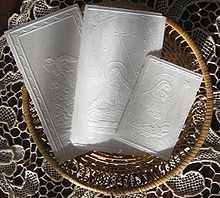- Christmas wafer
-
Christmas wafer (Polish: opłatek, plural opłatki; Lithuanian: kalėdaitis) is a Central European Christian Christmas tradition celebrated in Polish, Slovak and Lithuanian families during Wigilia (Christmas Eve Vigil).
The unleavened wafers are baked from pure wheat flour and water, are usually rectangular in shape and very thin; they are identical in composition to a round wafer which become the Host after the Consecration during Mass in the Roman Catholic Church. Being only a reminder of the Body of Christ used in private homes, Opłatki lack sanctification by a priest or bishop. The Opłatki wafers are embossed with Christmas related religious images, varying from the nativity scene, especially Virgin Mary with baby Jesus, to the Star of Bethlehem.
Contents
Polish tradition
Family members and friends break off a small piece of the opłatek wafer and give it to one another along with a blessing. Breaking off and exchanging part of opłatek with someone is symbol of forgiveness between two people and is meant to remind participants of the importance of Christmas, God, and family.
A sample blessing can take the form of "I wish you much health, happiness and the Lord's bountiful blessings as well as the fulfillment of all your plans and everything you wish for yourself." or just wishing good grades to a child and good health to your parents. It is also common to put a "shared part" into the envelope while you're sending a Christmas card to someone close to you so that during Christmas Eve supper someone could share it with you as well as those personally present. Another tradition, connected to the belief that during the Holy Night (the Night 24/25th Dec) animals could speak with a human voice, is to give the only coloured wafer to the farm animals. This tradition is still continued mostly in villages and farms.
The tradition of sharing the Opłatek wafer is one of the rich variety of traditions that Poles still celebrate during Christmas Eve Supper which is the most elegant and sumptuous evening in the whole year. Among others there are:
- partial fasting and full abstinence from meat; during December 24th families skimp on the quality and quantity of food, eating only two small meals before the great Christmas feast at supper
- eating dishes; there should be 12 of them (for the memory of 12 Apostles), no meat but there must be carp in various forms along with other kinds of fish
- putting some pieces of hay under the white table cloth (for the memory of Jesus lying on the hay)
- the meal is strictly closed to members of a family circle - however,
- one place at the table left for "the unexpected guest"
- carol singing at home and in church while waiting for the joyful Solemn High Mass at midnight to begin
Lithuanian tradition
Before the Kūčios meal starts, the families in Lithuania share kalėdaitis, also known as plotkelė, paplotėlis, plokštainėlis or Dievo pyragai depending on the region of Lithuania a family is from. A plate with as many wafers as there are persons participating in the meal is placed in the center of the table. Each member of the family is given a piece of unleavened wafer.
The head of the family, typically the oldest person present however often father of the family, then takes a wafer and offers it to a family member wishing them a Happy Christmas. "God grant that we are all together again next year", they respond and break off a piece of wafer. The family member then offers the head of the family a piece of their wafer in return. The head of the family then offers their wafer to every family member or guest at the table.
After them, all the diners exchange greetings and morsels of wafer. Care is taken not to skip anyone for that means terrible misfortune or even death the following year. In breaking a piece of wafer, each tries to get a piece larger than that remaining in the other's hand for it means his year will be better. The person holding the wafer tries to prevent a large piece being taken for this will "break his luck".
When everyone has exchanged wafers, the family members take their pile of wafers before the head of the house. He then looks of the wafers in the family member’s hands and reads a fortune from how they are assembled. After this has been completed, people return to their seats and the wafers are eaten.
Origins
The tradition traces its origins to the times of early Christianity (see Antidoron) and is seen as a non-sacramental foreshadowing of the liturgical partaking of the Holy Eucharist (Host), unleavened bread consecrated into the Body, Blood, Soul and Divinity of Jesus Christ. As a Christmas custom the “opłatek” originated in Poland and was spread widely as far back as the 17th century. It was the part of the szlachta's (Polish nobility) culture and the custom had spread throughout the Polish-Lithuanian Commonwealth and neighbouring countries. In the 19th century in the aftermath of the partitions of Poland it gained patriotic subtexts as the common wish during sharing of “opłatek” became the wish for Poland's regaining its independence. Since that time “opłatki” are often embossed with religious images. In the 20th century “opłatek” custom went beyond families and gained another meaning: the meeting of present or past co-workers or students.
See also
References
- Opłatki Wafers: Preserving Polish Christmas Eve Tradition. Visited 1/3/2005.
- A Christmas Eve feast, Polish style. Miami Herald. 1/23/2004. Visited 1/3/2005. Link is dead as of 6/10/2007.
Baked goods depicting religious iconography Categories:- Christmas food
- Polish traditions
- Polish cuisine
- Lithuanian cuisine
- Lithuanian traditions
- Slovak cuisine
- Flatbreads
Wikimedia Foundation. 2010.

